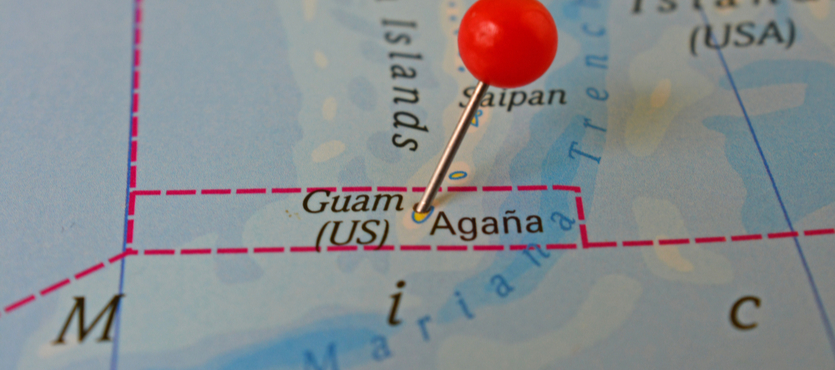With international tensions rising in the South China Sea, what was once a sleepy little island in the South Pacific is becoming an important forward operating base for the DoD and private military contractors.
In the airplanes’ first overseas deployment, a pair of MQ-4C Triton reconnaissance drones recently arrived in Guam. The Northrop-Grumman has a 60,000-foot cruising altitude and can remain aloft for 24 hours. Its 360-degree radar can transmit high-resolution images to nearby aircraft and bases. The Navy expects the Triton to be a big help in overcoming the so-called Great Wall of SAMs that rings the South China Sea.
The unmanned MQ-25 Stingray refueling drone, which recently completed its first successful test flight, may soon join the Triton on Guam, as the Navy looks to upgrade its long-distance fighting capacities.
In a related development, Black Construction Corporation received a $178 million DoD contract to replace Vietnam War-era housing units at Andersen Air Force Base. The vent-less duplexes are better suited to Guam’s climate and can withstand winds of up to 170mph. Construction should be complete by June 2022.
How We Got Here
Chamorros first came to Guam in what my children used to call “caveman times.” Many of today’s Guamites can trace their lineage back to these early settlers. These people had a highly advanced four-class social system. Ferdinand Magellan, a Spanish adventurer, stumbled upon Guam in 1521. For roughly the next 300 years, Guam was an important waystation and military strongpoint on the Manilla Galleons route between Mexico and the Philippines, both of which were under Spanish rule at the time. After the Napoleonic Wars ended in Europe in 1815, many Spanish overseas colonies, including Guam, took their first steps toward independence.
That path was blocked in 1898, when the United States acquired Guam after the Spanish-American War. Shortly thereafter, President William McKinley turned the island over to the U.S. Navy. Martial law remained in place until after World War II.
Apropos of nothing, Sergeant Shoichi Yokoi, who was one of the last Japanese holdouts from World War II, was discovered in the Guamian jungle in 1972. Yokoi lived alone in the jungle for about 10 years, after a flood killed his two remaining comrades. When he returned home, Yokoi made quite a splash by saying “It is with much embarrassment that I return.” He eventually received about $300 in back pay and a modest pension. In 1997, 82-year-old Shoichi Yokoi died after suffering a heart attack.
Partial civilian control returned to Guam in 1950. Beginning in 1968, the U.S. government allowed Guamites to choose their own governor.
Contractors in Guam
During the Vietnam War, many contractors were stationed in Guam at Andersen Air Force Base, in support of the 36th Wing of the 13th Air Force. Today’s contractors serve many of the same functions. These duties include:
- Equipment Maintenance: Sophisticated drones and other weapons of war require highly-specialized maintenance and highly-specialized operation. Additionally, as soon as the latest versions roll off the assembly line, the DoD usually needs new people to perform these roles. Since the military and the military academies usually do not prepare people for this kind of work, contractors flow in and out of Guam on a regular basis.
- Personnel Maintenance: Despite the advent of such weapons, armies still rely on people. These people have basic needs like everyone else. So, many Guam contractors are cooks and morale officers.
- Longshoremen: In isolated places like Guam, pretty much everything arrives and departs via oceangoing ship. So, experienced longshoremen are quite busy at Guam’s harbor facilities. The Defense Base Act is designed to protect people like these. The Longshoreman’s Division of the Department of Labor administers the DBA.
Additionally, contractors update the physical facilities. As the military presence increases, runways must be longer, more barracks are needed, and the list goes on.
Injury Compensation Available
The 1941 Defense Base Act provides benefits for private military contractors who are injured overseas. These benefits usually include compensation for both medical bills and lost wages.
A brief procedural aside. Although Guam is a U.S. territory, it is “overseas” for DBA purposes. In the Insular Cases (island cases), a group of decisions after the Spanish-American War, the Supreme Court declared that people who lived on Guam, Puerto Rico, the Philippines, and other newly-acquired territories were essentially second-class citizens.
These cases were quite controversial during the Jim Crow and Civil Rights eras, and they are still controversial today. But that is definitely the subject of another blog.
Guam has some procedural importance in another area as well. The “Special Zone of Danger” rule comes from a Guamian case. A contractor was injured during recreational activity, and the Supreme Court held that the Defense Base Act applied. Since he was in a remote war zone, the DBA was basically his only source of medical help.
That final procedural point — war zone — bears some explanation ,as well. Even though it is hundreds of miles from anywhere, Guam is a war zone. Any geographic territory which has any permanent U.S. military presence is a war zone.
Contact Barnett, Lerner, Karsen & Frankel, P.A. for more information about available DBA benefits.

